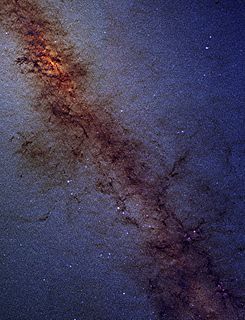
Galactic astronomy is the study of the Milky Way galaxy and all its contents. This is in contrast to extragalactic astronomy, which is the study of everything outside our galaxy, including all other galaxies.

The galactic coordinate system is a celestial coordinate system in spherical coordinates, with the Sun as its center, the primary direction aligned with the approximate center of the Milky Way galaxy, and the fundamental plane parallel to an approximation of the galactic plane but offset to its north. It uses the right-handed convention, meaning that coordinates are positive toward the north and toward the east in the fundamental plane.

Spiral galaxies form a class of galaxy originally described by Edwin Hubble in his 1936 work The Realm of the Nebulae and, as such, form part of the Hubble sequence. Most spiral galaxies consist of a flat, rotating disk containing stars, gas and dust, and a central concentration of stars known as the bulge. These are often surrounded by a much fainter halo of stars, many of which reside in globular clusters.

A supermassive black hole is the largest type of black hole, containing a mass of the order of hundreds of thousands, to billions of times, the mass of the Sun (M☉). This is a class of astronomical objects that has undergone gravitational collapse, leaving behind a spheroidal region of space from which nothing can escape; not even light. Observational evidence indicates that all, or nearly all, massive galaxies contain a supermassive black hole, located at the galaxy's center. In the case of the Milky Way, the supermassive black hole corresponds to the location of Sagittarius A* at the Galactic Core. Accretion of interstellar gas onto supermassive black holes is the process responsible for powering quasars and other types of active galactic nuclei.
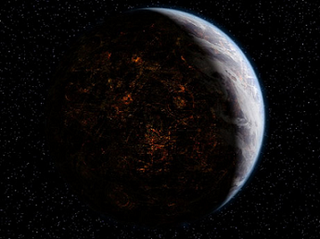
Coruscant is an ecumenopolis planet in the fictional Star Wars universe. It first appeared onscreen in the 1997 Special Edition of Return of the Jedi, but was first mentioned in Timothy Zahn's 1991 novel Heir to the Empire. Coruscant was historically referred to as Notron or Queen of the Core; was renamed Imperial Center during the reign of the Galactic Empire and Yuuzhan'tar during the Yuuzhan Vong invasion. The planet's capital city was initially Galactic City ; under the Galactic Empire this was Imperial City, and was Republic City or the City Of Spires under the Galactic Republic. The planet was code-named Triple Zero during the Clone Wars. The demonym and adjective form of the planet name is Coruscanti.

The galactic plane is the plane on which the majority of a disk-shaped galaxy's mass lies. The directions perpendicular to the galactic plane point to the galactic poles. In actual usage, the terms galactic plane and galactic poles usually refer specifically to the plane and poles of the Milky Way, in which Planet Earth is located.

Sagittarius A* is a bright and very compact astronomical radio source at the center of the Milky Way, near the border of the constellations Sagittarius and Scorpius. It is part of a larger astronomical feature known as Sagittarius A. Sagittarius A* is the location of a supermassive black hole, like those that are now generally accepted to be at the centers of most if not all spiral and elliptical galaxies. Observations of a number of stars, most notably the star S2, orbiting around Sagittarius A* have been used to show the presence of, and produce data about, the Milky Way's central supermassive black hole, and have led to the conclusion that Sagittarius A* is the site of that black hole.
A galactic halo is an extended, roughly spherical component of a galaxy which extends beyond the main, visible component. Several distinct components of galaxies comprise the halo:
The terms galactic corona and gaseous corona have been used in the first decade of the 21st century to describe a hot, ionised, gaseous component in the Galactic halo of the Milky Way. A similar body of very hot and tenuous gas in the halo of any spiral galaxy may also be described by these terms.

The Orion Arm is a minor spiral arm of the Milky Way some 3,500 light-years across and approximately 10,000 light-years in length, containing the Solar System, including the Earth. It is also referred to by its full name, the Orion–Cygnus Arm, as well as Local Arm, Orion Bridge, and formerly, the Local Spur and Orion Spur.

Star Wars: Galactic Battlegrounds is a real-time strategy video game set in the Star Wars universe. It was developed by Age of Empires developer Ensemble Studios and LucasArts. It was released in November 11, 2001. An expansion pack, Clone Campaigns, was released in May 14, 2002, adding two new factions and campaigns. Later that year, both Galactic Battlegrounds and Clone Campaigns were released in a box set, Star Wars: Galactic Battlegrounds Saga.

The Milky Way is the galaxy that contains our Solar System. The name describes the galaxy's appearance from Earth: a hazy band of light seen in the night sky formed from stars that cannot be individually distinguished by the naked eye. The term Milky Way is a translation of the Latin via lactea, from the Greek γαλαξίας κύκλος. From Earth, the Milky Way appears as a band because its disk-shaped structure is viewed from within. Galileo Galilei first resolved the band of light into individual stars with his telescope in 1610. Until the early 1920s, most astronomers thought that the Milky Way contained all the stars in the Universe. Following the 1920 Great Debate between the astronomers Harlow Shapley and Heber Curtis, observations by Edwin Hubble showed that the Milky Way is just one of many galaxies.
The Milky Way is a barred spiral galaxy with a diameter between 150,000 and 200,000 light-years (ly). It is estimated to contain 100–400 billion stars and more than 100 billion planets. The Solar System is located at a radius of 26,490 light-years from the Galactic Center, on the inner edge of the Orion Arm, one of the spiral-shaped concentrations of gas and dust. The stars in the innermost 10,000 light-years form a bulge and one or more bars that radiate from the bulge. The galactic center is an intense radio source known as Sagittarius A*, assumed to be a supermassive black hole of 4.100 million solar masses.

NGC 17, also known as NGC 34, is a spiral galaxy in the constellation Cetus. It is the result of a merger between two disk galaxies, resulting in a recent starburst in the central regions and continuing starforming activity. The galaxy is still gas-rich, and has a single galactic nucleus. It lies 250 million light years away. It was discovered in 1886 by Frank Muller and then observed again later that year by Lewis Swift.

The galactic year, also known as a cosmic year, is the duration of time required for the Sun to orbit once around the center of the Milky Way Galaxy. Estimates of the length of one orbit range from 225 to 250 million terrestrial years. The Solar System is traveling at an average speed of 828,000 km/h (230 km/s) or 514,000 mph (143 mi/s) within its trajectory around the galactic center, a speed at which an object could circumnavigate the Earth's equator in 2 minutes and 54 seconds; that speed corresponds to approximately 1/1300 of the speed of light.
GCIRS 13E is an infrared and radio object near the galactic centre. It is believed to be a cluster of hot massive stars, possibly containing an intermediate-mass black hole (IMBH) at its centre.
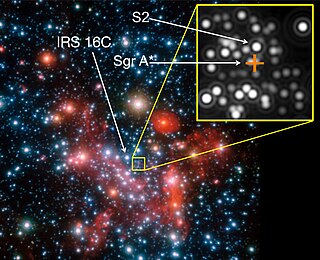
S2, also known as S0–2, is a star that is located close to the radio source Sagittarius A*, orbiting it with an orbital period of 16.0518 years, a semi-major axis of about 970 au, and a pericenter distance of 17 light hours – an orbit with a period only about 30% longer than that of Jupiter around the Sun, but coming no closer than about four times the distance of Neptune from the Sun. The mass when the star first formed is estimated by the European Southern Observatory (ESO) to have been approximately 14 M☉. Based on its spectral type, it probably has a mass of 10-15 solar masses.
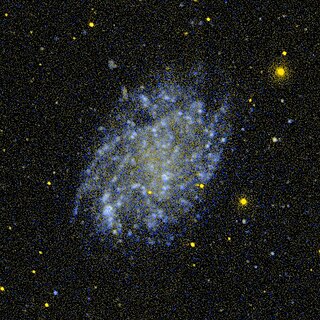
NGC 45 is a low surface brightness spiral galaxy in the constellation of Cetus. It was discovered on 11 November 1835 by the English astronomer John Herschel.
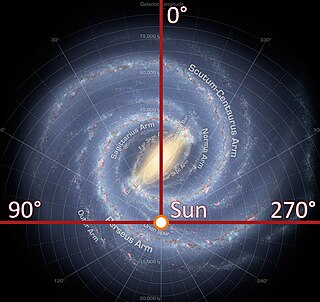
A galactic quadrant, or quadrant of the Galaxy, is one of four circular sectors in the division of the Milky Way Galaxy.
In astrobiology and planetary astrophysics, the galactic habitable zone is the region of a galaxy in which life might most likely develop. More specifically, the concept of a galactic habitable zone incorporates various factors, such as metallicity and the rate of major catastrophes such as supernovae, to calculate which regions of the galaxy are more likely to form terrestrial planets, initially develop simple life, and provide a suitable environment for this life to evolve and advance. According to research published in August 2015, very large galaxies may favor the birth and development of habitable planets more than smaller galaxies such as the Milky Way. In the case of the Milky Way, its galactic habitable zone is commonly believed to be an annulus with an outer radius of about 10 kiloparsecs and an inner radius close to the Galactic Center.
